-
(b.) - ?1923 March 28
Bio/Description
A British computer scientist, and Emeritus Professor at the School of Computing Science, Newcastle University, U.K., he specializes in research in software fault tolerance and dependability, and is a noted authority on the early prior to 1950 history of computers. He is a British computer pioneer who worked on the development of digital computing in the 1940s. At first, an assistant to Alan Turing, no little distinction in itself, he went on to play important parts in the development and application of the Pilot ACE and ACE computers at the National Physical Laboratory, and later in the methodology, design and documentation of programming languages, especially ALGOL 60 and Ada. He was born in Epsom, Surrey, England, the eldest of four children. His father Joseph Henry Woodger was emeritus professor of biology in the University of London, and one of his particular ambitions was the construction of a foundation of mathematical logic for biology, based on Whitehead and Russell′s work on the logical basis of mathematics. He taught his son symbolic logic as soon as he was able to follow it. This unusual early grounding in rigorous scientific thinking, and particularly in formal methods, evidently planted a seed which was to grow and bear fruit a hundredfold. After graduating in mathematics from University College London in 1943 and working on military applications for the remainder of World War II, he joined the newly-established Mathematics Division of the National Physical Laboratory (NPL) at Teddington in south-west London in May 1946. After a short period of training in numerical analysis, the main subject of the Division?s work, he was introduced to Turing?s plans for the ACE computer and von Neumann?s plans for EDVAC. He then assisted Turing with detailed logical design and experimental hardware, the latter including an abortive attempt to make an acoustic delay line store using the air column in a drainpipe. He and Turing shared a common interest in logic. Eventually, after Turing?s departure in 1947 and NPL?s belated recruitment of staff with experience of pulse electronics, the development of a computer to be known as the Pilot ACE was undertaken in earnest. His main task was writing standard procedures for mathematical operations, which were successfully tested and put to use when Pilot ACE became operational in 1950. He also played a vital part in the application of Pilot ACE to practical problems. In an (unpublished) interview recorded in 1980 he says ?I ended up developing an automatic system for handling matrices of reasonable size in the store?and this was very, very successful?. Indeed it was; his system allowed a whole program of matrix manipulations to be specified for the machine by someone not familiar with the machine language. It included space-saving and error checking facilities, and it was rewritten for the DEUCE and in this form widely used well into the 1960s. This work was important in two ways: it made the machines available to more users more efficiently and so greatly extended the range of applications to which they were put. Also, from a historical perspective, it proved to be one of the earliest practical steps on the road to modern high-level computer languages. In similar vein, the development of the ALGOL 60 language is mentioned in the same interview, but he, modest chap that he is, does not stress the importance of his own contribution, which lay particularly in organising and capturing, in a precise written form, the ideas of Peter Naur and his other fellow members on the International ALGOL Committee. He is one of the joint authors of the ALGOL 60 report, a milestone in the history of programming languages. At the time the interview was held in July 1980, He had started his second period as chairman of IFIP Working Group 2.3, the international forum for discussion of programming methodology. In this work he had stressed the idea that, since a large program is best constructed as a set of modules in such a way that modules at one level use the services of modules at the next lower level and provide a service to modules at the next higher level, the design of programming languages should reflect these same structural concepts. Each level should have its own terminology and not be cluttered with either text or concepts appropriate to other levels. His ideas, have stood the test of time very well. His next contribution, acting as consultant to a consortium led by CII - Honeywell Bull, was to the design of the language at first called Green, one of the four contenders short-listed in a competition to establish a standard language for use in the US Department of Defense. The language was renamed Ada after its success in the competition in 1979. He continued his contribution via Alsys S.A., a French company developing Ada documentation, both before and after his retirement from NPL in 1983. Jean Ichbiah, the head of this company, described him fittingly as ?an artist of technical writing?. His part-time work for Alsys ended in 1991. Fortunately for those interested in the history of computing, he has throughout his career kept documents and records systematically. When he retired from NPL the historical part of this considerable collection was moved to the library of the Science Museum in South Kensington, London, so that it could be made available to those with appropriate specialist interests. The computing world has been fortunate that he saw the vacancy notice for mathematicians at NPL in 1946. It led him to a career which was to prove ideally matched to his talents: clarity of thought, ability to handle complex abstract concepts and meticulous attention to detail, qualities he has continued to show to the present day.
-
Date of Birth:
1923 March 28 -
Gender:
Male -
Noted For:
Co-author of the ALGOL 60 report, a milestone in the history of programming languages -
Category of Achievement:
-
More Info:


